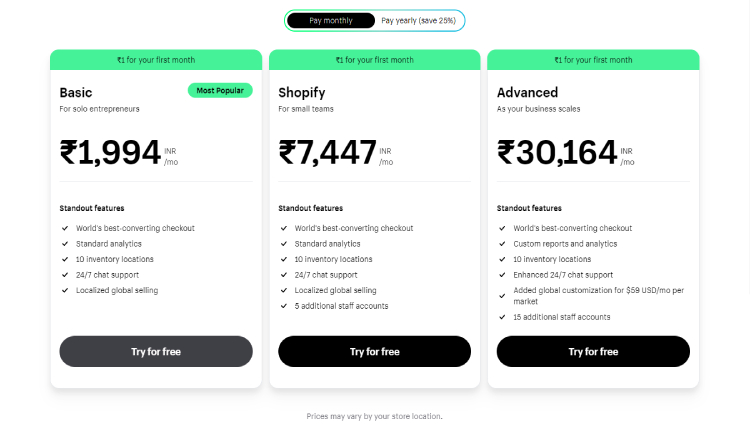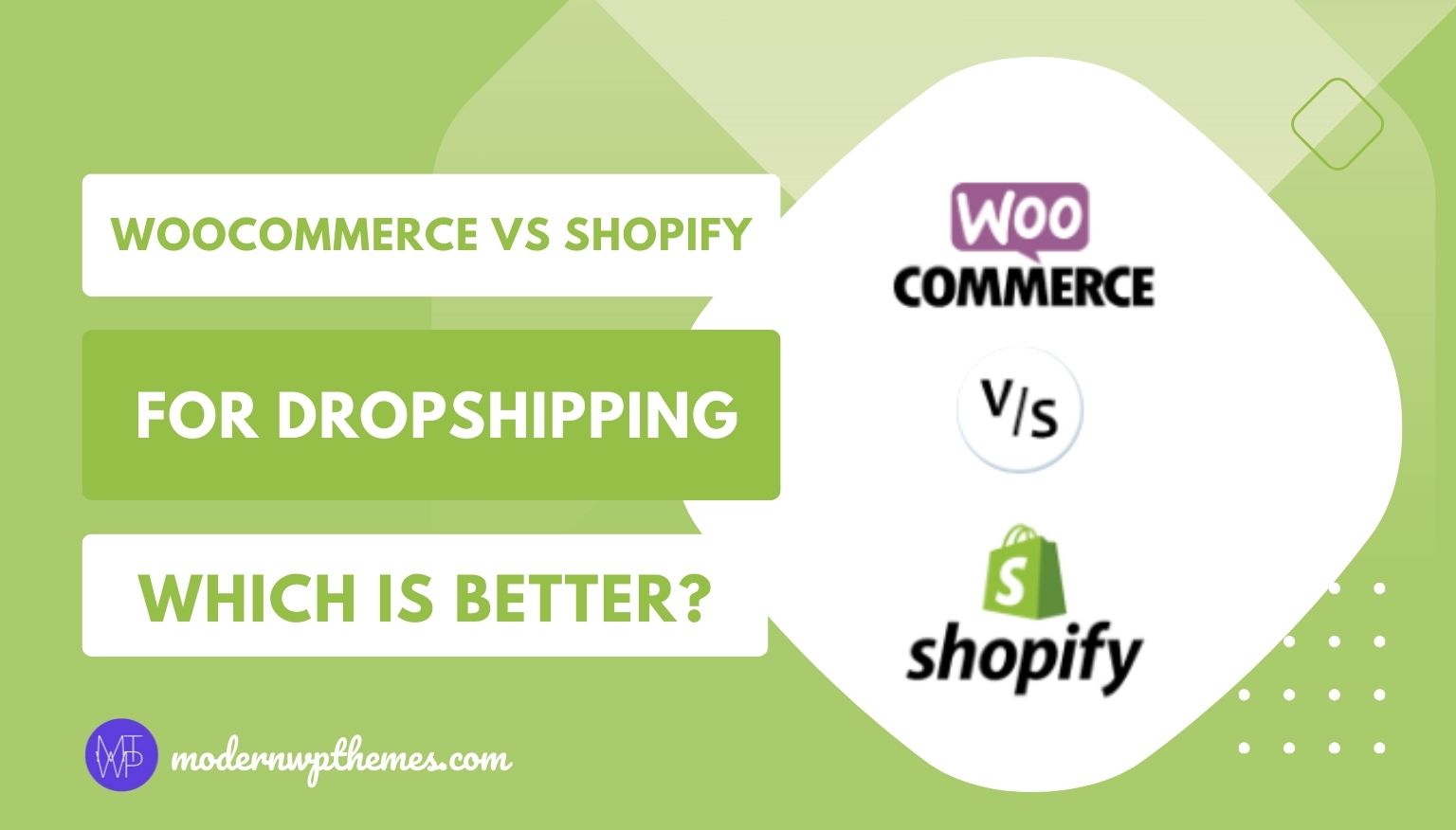Are you planning to start your own dropshipping business? If so, but find yourself confused between WooCommerce and Shopify, which one is better? Well, don’t worry, you’ve come to the right place. Here, I’ll try my best to break down the difference between these two most popular e-commerce platforms in simple terms. So, it will clear all your doubts and help you out to choose the right platform for your dropshipping business.
Let’s talk about some basic things about these platforms. WooCommerce and Shopify are both the best options for starting an online store but they have some key differences that you should know about. Actually, WooCommerce is a WordPress plugin and it is a little technical to set up an online store, but the main thing is that it offers flexibility and tons of customization options. While on the other side, Shopify is a complete e-commerce platform, which is easy to use even for beginners.
If we talk about managing online dropshipping products, Shoipfy has a streamlined system along with some helpful features like bulk import/export product data and automatic inventory tracking. But when it comes to WooCommerce, it gives more control over product listings and their attributes. This can be a great feature, especially if you have a large or diverse product catalog.
Coming to the most important factor, which is pricing. Well, Shopify charges on a monthly subscription basis, which includes hosting and some other features. While WooCommerce is free, but you’ll need to pay for the domain, hosting, and any add-on features you want to include.
In this article, we’ll explore this in detail along with some other considerations like scalability, SEO capabilities, payment gateways, customer support, etc. So, after going through this article, you’ll have a good understanding of the pros and cons of both Shopify and WooCommerce, and that will help you to confidently choose which platform is good for your business.
Alright, let’s explore together: WooCommerce vs Shopify, which one is better?
WooCommerce vs Shopify For Dropshipping In India : Which One Is Better?
1. Ease of Use
When it comes to how easy to use, Shopify and WooCommerce both are different and suitable for different levels of technical skills.
Shopify:
Shopify is very much popular for its user-friendly design which makes it easy to use for all skill levels. It doesn’t matter whether you are a beginner or have some knowledge, its easy to set up the process and straightforward navigation helps you to build your online store quickly and efficiently.
The best thing about Shopify is that it offers you a drag and drop editor which allows you to customize your online store without requiring any coding skills. Additionally, Shopify also provides comprehensive documentation and good customer support, which means you can get help whenever you need it.
WooCommerce:
As we already discussed WooCommerce is a WordPress plugin and it requires a little bit of technical skill as compared to Shopify. However, if you are familiar with WordPress then you can easily be familiar with the WooCommerce interface too.
But don’t worry it takes some time to get accustomed to the WordPress dashboard and WooCommerce store settings. However, the plugin offers extensive customization options and control over your online store’s functionality and appearance.
On top of that, for WooCommerce there is a vast community developers and users who provide support to optimize and troubleshoot your Woocommerce store.
2. Product Management
Managing your online products in a well-organized way is crucial to run a successful e-commerce store. So, let’s check out how Shopify and WooCommerce manage the products.
Shopify:
With Shopify, you’ll get a streamlined product management system along with its user-friendly tools for adding, editing, and organizing your online products. In addition, you can easily import your product data in bulk, automatically track your inventory levels, and also set up product variants.
To organize your online store in a proper way, Shopify gives options like collections, categories, and tags. Because of its user-friendly interface, managing your products on Shopify is easy, even if you’re a beginner.
WooCommerce:
Inside the WordPress environment, WooCommerce provides good product management capabilities like it gives you complete control over your product listings, categories, and attributes. Also, adding and editing product details is very simple, if you are familiar with WordPress.
In addition, WooCommerce gives you flexibility in managing your product inventory levels, variations, and pricing options. To take your product management capabilities to the next level you can leverage WordPress plugins. With WooCommerce you can extensively customize your online store as per your requirements but doing that requires technical skill.
3. Dropshipping Integration
Dropshipping integration is an essential step to making the process easy to managing orders from suppliers. Let’s check which one is better on dropshipping integration, Shopify or WooCommerce.
Shopify:
It has its in-built dropshipping apps and tools such as Oberlo, Spocket, and Printful that make your dropshipping business a breeze. These in-built apps of Shopify allow you to import your products from suppliers, manage inventory, and fulfill your orders with the help of a few clicks.
Also, its in-built features and extensive app ecosystem, make your dropshipping process very easy. What’s more, it also has some interesting features such as tracking your orders, automatically syncing your product inventory levels, and the most useful feature which is notifications for out-of-stock products. All these things ensure a smooth process for your dropshipping business.
WooCommerce:
When it comes to WooCommerce, it doesn’t have its in-built dropshipping integration like Shopify but is compatible with available WordPress dropshipping plugins and extensions. For WooCommerce dropshipping integration you’ll get WordPress plugins such as WooDropship, AliDropship, and Dropified that help you to connect your WooCommerce store with your dropshipping suppliers, and import and manage products efficiently.
Because of WooCommerce’s open-source behavior, you get the flexibility to customize your dropshipping setup as per your needs and requirements. Moreover, in WooCommerce setting up the dropshipping may need initial configuration as compared to Shopify. The plugins which are available for the dropshipping give proper solutions for managing the dropshipping process effectively.
4. Plans and Pricing
This is one of the most important factors knowing how much each platform is charging and based on that it’ll help you to make an informed decision on which platform is suitable for you as per your budget. So, let’s have a look at how much Shopify and Woocoomerce are charging.
Shopify:
Shopify offers you 3 different plans such as Basic, Shopify, and Advanced, which you can choose from according to your budget and business requirements. These plans include:

Basic – ₹1,994/month (₹1,499 per/month, Paid Annually): This is the perfect plan for small businesses or for those who want to start their online business, it offers you all the essential features to get your online store up and running. To get your business online, if you just need e-commerce functionality then this Basic plan is just for you.
Still, this is a basic plan Shopify offers amazing features like gift cards, discount codes, abandoned cart recovery, and many more. With this plan, you do not get any additional staff accounts but if you need it then you need to go with the Shopify plan.
One important thing that you should know is that the Transaction fee for this plan is 2% which is more than the other two plans.
Shopify – ₹7,447/month (₹5,599/month, Paid Annually): If you have a small business and it is growing then this plan is suitable for you. With this plan, you’ll get 5 Additional Staff Accounts, using this account your staff can help you to run your store by accessing the product pages and customer data.
When it comes to transaction fee then it this plan will charge you 1% which is less than the previous plan. Also, if you are looking for features that calculate shipping rates, duties, and import taxes at the checkout page then it is not included in this plan. Wait, you’ll get that feature, and for that need to go for the Advanced plan.
Advanced – ₹30,164/month (₹22,680/month, Paid Annually): This plan is suitable for medium to large-sized online businesses that are poised for growth. With this plan, you’ll get all the features that are not included in previous plans, such as third-party calculated shipping rates, 15 additional staff accounts, custom reports, and analytics, estimating and collecting duties and import taxes at the checkout page, etc. Furthermore, the transaction fee in this plan is only 0.6%, which is the lowest rate compared to the previous two plans.
WooCommerce:
As we all know, WooCommerce is a WordPress plugin that is free of cost. However, apart from that, there are various other costs which are essential to run a successful WooCommerce online store. These costs may include:
Domain Name: To start a WordPress website, first you’ll need a domain name, which typically incurs a yearly fee.
Hosting: After that, you’ll need a hosting provider to host your WordPress website, the price range of hosting can vary depending on the plan that you have chosen.
Premium Extensions and Themes: WooCommerce offers a wide range of free extensions and themes. However, for additional features and customization options, you’ll need premium addons/plugins or themes. The pricing for premium addons/plugins or themes may incur one-time or recurring costs
One of the significant benefits of using WooCommerce is its flexibility in terms of pricing. The reason I’m mentioning this is that here you have the freedom to choose your domain registrar, hosting provider, and if you require any features, you can add them based on your budget and requirements.
5. Customization and Flexibility
This is one of the key factors when we are going to choose a platform for dropshipping or e-commerce. Let’s compare how Shopify and WooCommerce stack up for their customization and flexibility:
Shopify:
Shopify offers you a wide range of options to customize your online store by using the theme editor and app store to make it as you want. Also, there are plenty of ready-made themes available which you can choose from, if you can’t get one then you can tweak it to make it suitable for your brand.
Additionally, the Shopify app store offers a wide range of apps to assist you with everything you need for your online business, from marketing to managing your product stock. But if you require complete flexibility, then WooCommerce might be a better option than Shopify.
WooCommerce:
Because WooCoomerce has an open-source nature and integration with WordPress, WooCoomerce gives unparalleled flexibility and customization capabilities. With WooCommerce, you’ll get full control over every aspect of your online store such as from design to features and functionality.
For the WooCommerce store, you’ll get thousands of free and premium themes and in case if you want to create your own, you can do that by either creating a theme from scratch or can modify any theme. On top of that, WooCommerce has wide-range of plugins and extensions available which can extend the capabilities of your store’s specific requirements and needs.
6. SEO and Marketing
SEO (Search Engine Optimization) and marketing are crucial things to growing your business online because, with the help of these, you can drive traffic to your online store and increase your sales. Okay, so let’s compare how Shopify and WooCommerce support SEO and marketing efforts:
Shopify:
Well, Shopify has its built-in feature for On-Page SEO that helps you improve your website’s visibility and ranking in search results. This On page SEO feature gives the options for customizing title tags, meta descriptions, and URLs. Also, it generates a sitemap automatically.
Additionally, if we talk marketing tools then Shopify integrates with some popular marketing tools such as Google Analytics, Facebook Ads, and email marketing platforms. With these marketing features, you can create and manage your campaigns, track performance metrics, and optimize campaigns to drive traffic and sales.
WooCommerce:
By installing an SEO plugin in your WooCommerce WordPress website, you can easily do On-Page SEO and improve your online store’s search engine ranking and visibility. WooCommerce works well with almost all the popular SEO plugins. This plugin gives you full control over title tags, meta descriptions, and permalinks to ensure your site ranks well in search results.
Speaking about WooCommerce’s marketing tools, it is more flexible than Shopify, as it offers a wide range of free and paid plugins for email marketing, social media marketing, and content marketing. These tools help attract more visitors to your online store.
7. Customer Support
This is a crucial aspect to ensure that you can receive reliable customer support when needed. So, let’s explore how Shopify and WooCommerce offer customer support:
Shopify:
Shopify offers 24/7 customer support through various channels including email, phone calls, and live chat. If you encounter any issues during setup or while running your online store and require assistance, their dedicated support team is available to help resolve your concerns. In addition to the support team, Shopify provides tutorials, documentation, and a highly active community forum where you can find answers to common questions.
WooCommerce:
For WooCommerce, you don’t receive 24/7 dedicated support like Shopify, but you do have access to support through documentation, community forums, and user-generated blogs. Additionally, you can find solutions for common issues, troubleshooting tips, and guidance from experienced developers and WordPress users within the community.
8. Scalability
Scalability is also an important factor to making sure your online store can keep up with your growing online business. So, let’s check out how Shopify and Woocommerce deal with it:
Shopify:
Shopify is popular for its plans, pricing, features, and scalability, catering to businesses of all sizes. Whether you’re starting your online store or have a growing online business, Shopify can meet your needs.
Thanks to its cloud-based infrastructure, Shopify can easily handle high traffic on your online store and large product catalogs without compromising performance. Additionally, Shopify’s app store offers a wide range of scalable solutions to expand your online store’s functionality as your business grows.
WooCommerce:
WooCommerce is highly scalable compared to Shopify because it integrates with WordPress and offers a wide range of available plugins. Whether you’re running a small online store or a large one, WooCommerce can easily scale to meet your business requirements.
Built for WordPress, WooCommerce provides flexibility and customization options to grow your business. If you want to add extra features and functionalities to your WooCommerce store, you can easily do so by adding plugins that will help you scale your online business efficiently.
9. Payment Gateways
For running an online store, the Payment gateway is one of the crucial parts for processing transactions securely. Let’s dive into how Shopify and WooCommerce support payment gateways:
Shopify:
For payment gateways, Shopify offers plenty of in-built options, including Shopify Payments, which enables you to accept credit card payments directly from your online Shopify store.
In addition, Shopify has seamlessly 100+ third-party payment gateway options which give you flexibility in selecting the right payment gateway option as per your business. However, it’s important to note that Shopify offers payment gateway options for accepting payments globally or locally.
WooCommerce:
Well, WooCommerce also provides flexibility regarding payment gateways, allowing you to select from a wide range of options that suit your business needs. By default, WooCommerce offers some popular payment gateways, including PayPal and Stripe.
Additionally, WooCommerce offers plenty of plugins that help integrate other payment gateways, ensuring you can accept payments from around the world.
10. Data Ownership and Control
If you have concerns about data ownership and control while choosing the platform for dropshipping then here we’ll compare how Shopify and WooCmmerce handle and manage data ownership and control.
Shopify
As we all know, Shopify has its own servers, and all Shopify stores are hosted there. However, you can access your store’s data, but ultimately Shopify has control over the servers and infrastructure. Shopify mainly takes measures to keep the data available on their servers secure, which is why you may have limited control over server settings and backups.
WooCommerce
When it comes to ownership and control, WooCommerce gives more control over it as compared to Shopify. Since WooCommerce is hosted on a self-hosted server, you have complete control over your data. On a self-hosted server, you can configure your server settings, take backups, and also add some security measures if needed.
11. Platform Maintenance and Updates
Keeping your online store up-to-date is a crucial step for performance and security reasons. Let’s explore which platform conducts regular maintenance and updates.
Shopify
On Shopify, maintenance and updates are managed automatically by the Shopify team. This means you don’t need to worry about updating and managing server maintenance tasks manually. The Shopify team takes care of everything, including performance optimizations, security patches, software updates, etc., ensuring that your online store remains up-to-date and secure.
WooCommerce
As we all know, WooCommerce is run on a self-hosted server, which means you need to take care of the maintenance and updates of your online store. This gives you more control over it, but on the other side, you need to be proactive in managing software updates, optimizing performance, etc. Whenever updates for WordPress, WooCommerce plugins, and themes are available, you need to keep an eye on them to ensure your online store remains secure and up-to-date.
Final Thoughts
In conclusion, WooCommerce and Shopify both offer unique advantages for dropshipping businesses, depending on your budget, preferences, and business requirements.
Shopify provides a user-friendly, all-in-one solution with robust dropshipping integrations such as easy store setup, automatic updates, and excellent customer support, making it ideal for those new to online business.
On the other hand, WooCommerce offers unparalleled flexibility, customization options, and complete control over data and servers, making it the preferred option for experienced business owners with specific requirements.
When it comes to making a decision between these two platforms, it is important to consider factors like ease of use, scalability, customization, payment gateways, data ownership, maintenance, and community support. By assessing your budget, business requirements, technical expertise, and your long-term goal will help you in deciding which online platform is good for a dropshipping business.
Lastly, both Shopify and WooCommerce have a proven track record of running successful online stores. Before making any decision, carefully evaluate the benefits, features, and trade-offs of each platform to help you make an informed decision that lays the foundation for your online venture.





